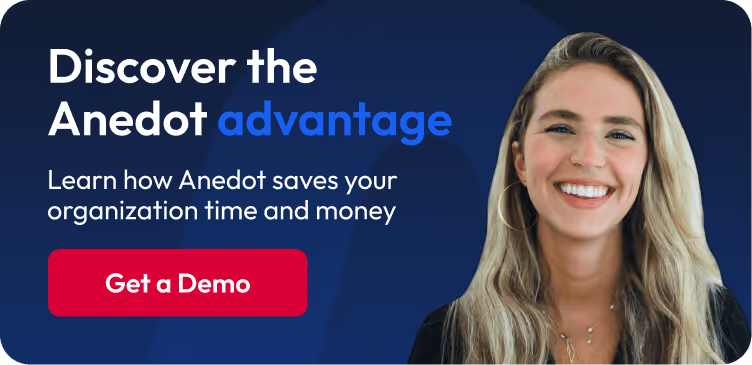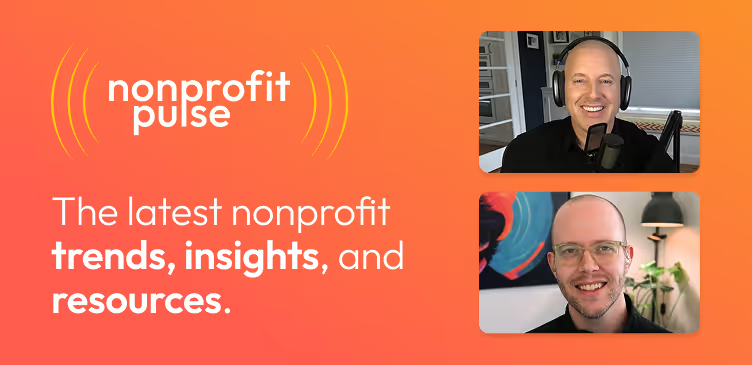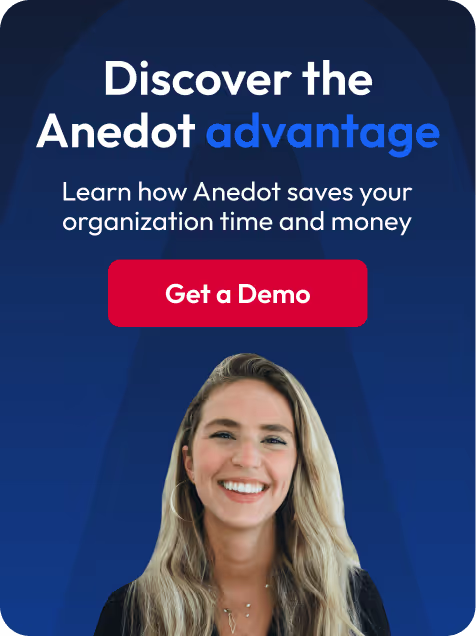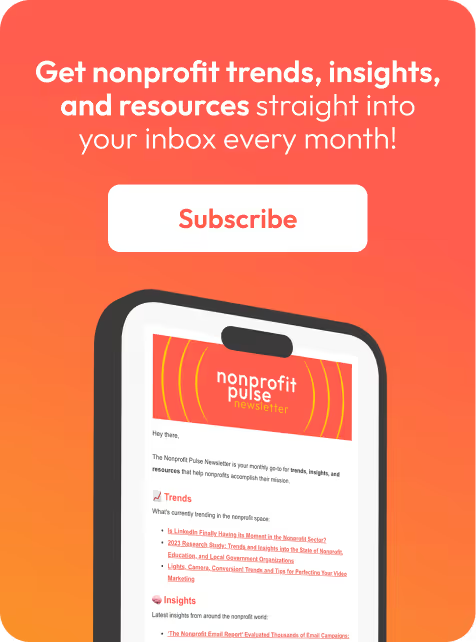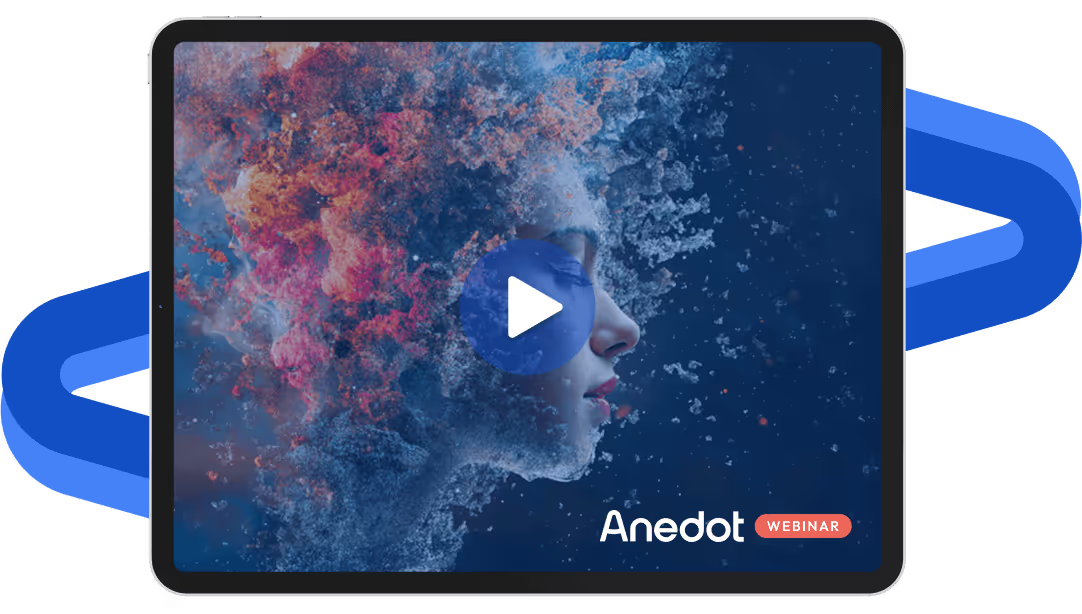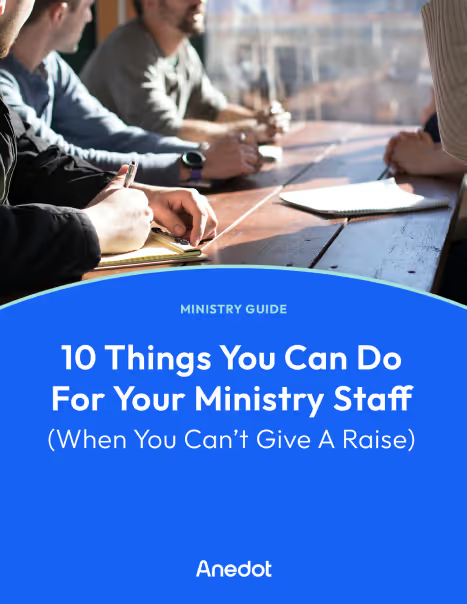Podcast episode transcript ↓
Josh:
Nonprofits are nothing without their team. With recent employee engagement metrics falling across industries, nonprofits are not immune to these realities.
But how can nonprofit leaders go about measuring and improving poor employee engagement on their teams? And how does nonprofit employee engagement differ from the for-profit sector?
I’m Josh with Anedot, and welcome to Nonprofit Pulse where we explore trends, insights, and resources that help nonprofits accomplish their mission.
On this episode we are joined by Holly Tate on the topic of employee engagement and development.
Holly is the Chief Marketing Officer at Leadr, a software that equips managers with the digital workspace they need to grow, engage and lead high-performing teams.
With more than a decade serving nonprofit leaders, Holly brings a wealth of experience in nonprofit hiring, management, and leadership.
Hey, Holly, thanks so much for joining us.
Holly:
Thanks for having me. I'm glad to be here.
What is employee engagement?

Josh:
Today, we have an exciting topic. We're talking about employee engagement.
And I love this topic for businesses, but also love it for nonprofits with how people centered nonprofits are and the unique challenges that the nonprofit employees face and nonprofit leaders face and leading them well.
So maybe just first, let's talk about what is employee engagement? How would you define employee engagement?
Holly:
Yes, I'm so glad that we're spending the first part of our conversation around defining it, because it is such a buzz word, but it can feel so nebulous.
And I get this question a lot because there's this a stat from Gallup that from a few years ago, I think in 2019, it was that 80% of the workforce is engaged and it's gotten a bit better.
I think it's like 85% now, which is nice. That was I think their 2022 or 2023 report. I don't remember exactly what year.
So we're making progress. But then the question that I get that's the follow up is, well, what does that even mean?
And so I think we can all, we all know that person on our team that's not engaged.
So sometimes I think it's helpful to start there first.
We know that person that is causing sideways energy that's just showing up, giving it their bare minimum. They don't feel bought into our mission or the overall goals of what we're trying to achieve.
And so if that's disengagement, then the opposite end of that spectrum, engagement is someone who is thriving in their role.
They are aligned with the overall mission of our nonprofit. They are rowing in the same direction and want to do what's best for the overall organization.
That is what it feels like to work with the team or a person that is engaged.
And so it's hard to measure, but I think we all know what that feels like when we're sitting alongside that person on our team that is not engaged or that really is engaged.
What are some challenges of employee engagement in nonprofit organizations compared to for-profit businesses?

Josh:
Yeah, when I think about employee engagement, I mean just the past three years has been crazy with the topic because of quiet quitting, I mean, first the pandemic and then the quiet quitting.
And now with recent layoffs across sectors, it seems like, you know, employee health is another topic in a different kind of area of what does it feel like to be laid off or living in fear of being laid off or financial challenges.
So maybe that's a good segway into thinking through what is it, what challenges do you see that nonprofits are facing in engaging with their employees to keep them engaged, to keep them motivated, enthusiastic and maybe compare that to for-profit companies?
What do you see?
Holly:
Yeah, absolutely.
I mean, I think the most evident one is resources. I mean, any organization, whether you're for-profit or nonprofit, at the end of the day, you're dealing with resources, resources of finances, resources of people.
And it's a matter of prioritizing those resources in order to get the job done in whatever that looks like. The challenge that nonprofits face is that they often are fundraising.
They are stewarding the finances that they have been given. And while for-profits are accountable to that, there's often there's a board or there are shareholders that for-profits are accountable to.
There's typically a lot more autonomy because there is more of a consistent cash flow coming in the door.
Whereas nonprofits, it can ebb and flow and it can change from year to year.
And so the weight of responsibility that is on the resource of finances can often cause a scarcity mindset that I think a lot of nonprofits face, which is if we spend this on this, are we going to get the results that we really want to see?
And when it comes to our people, a lot of times that's not a, it's not a line on our budget.
Now, payroll is. That's what's so interesting is payroll is there. It's often the largest line item in our budget or on our P&L statement.
But when it comes to employee engagement or people development or culture, you don't see a lot of line items of that being budgeted for, which I think is a mistake.
I think it should be a line item on our budget because our people, our payroll is such a huge part of our budgets.
And so in the nonprofit space, I think the challenge is not only the practicality of limited resources and having to fundraise that money. And it feels like every penny counts, but also having to justify every expense.
And I often see nonprofits struggle to invest in those areas that don't have as much of a, quote unquote, bottom line impact.
But when it comes to employee engagement and people development, that is what ultimately drives performance.
But we often miss the mark there and think, we need better systems or processes or we need to, you know, invest in this increase in technology or whatever that might be.
That's more of a tangible output, rather than the input of making sure that our people are engaged and thriving, which is critical in a nonprofit world where there's a lot of burnout because often people are paid less, they're there for the mission because they believe in it, and they are often paid less than if they went elsewhere.
And if they don't feel like they're cared for and developed and engaged in their work, that's where we face burnout.
We face lower productivity, and that's where we're going to lose momentum around our mission.
So I think those are a few of the unique challenges that nonprofits face compared to for-profits that typically not always, but typically have a bit more autonomy in the resources and how they're spending them.
How does the mission-driven nature of nonprofits impact employee engagement and motivation?

Josh:
Yeah. How do you see the mission driven nature of nonprofit work impact employee engagement and motivation?
How do you, how do you see that? Because I think it's a blade or a knife that cuts both ways, right?
When you onboard someone into your nonprofit, you want to make sure that they're committed to the mission, that they're driven by the mission.
But at the same time, it seems like the mission can become first instead of the health of the staff, who are often giving so much emotional labor, so much of their essence in their life to this work. How do you see that?
Holly:
Absolutely. I mean, Josh, you described that so well, I see it.
I work with a lot of nonprofits in the work that I do, and I see it every single day where they, you know, the individual became, it was a recruiting tool, right? It's like I want to do work that matters.
So I want to work for this nonprofit that is on mission for something that I really care about.
And so on the one hand, it's an incredibly amazing competitive advantage for nonprofits that from a recruiting perspective, from a hiring perspective, that at the beginning people tend to show up their best self and are so excited.
But to your point, when we you know the phrase it's so cliche, but it is so powerful that you cannot pour from an empty cup and that is often what nonprofit folks are having to do because they're under-resourced and they're overworked.
And so the, what can often be a competitive advantage can also be used, can be weaponized to say, well, I know we don't pay you very much, but look at the exciting work you're doing.
And in a perfect world, when we are, not even a perfect world, I mean, this should just be the status quo.
As leaders of nonprofits, we should be prioritizing the care and health and development of our people, because that's how that important work gets done. And so making sure that we are not only providing benefits and fair compensation, but also looking for those opportunities for recognition and making sure that our teammates see how the work that they're doing today directly impacts the mission that they came on board for.
Telling those stories, finding creative ways outside of just finances to reward team members and employees, making sure that we're providing enough time off and mental health days and making sure that our team is able to be to feel to be able to thrive and seek health so that they can come to work each day and show up as their best self and pursue excellence in the meantime.
So, I mean, everything this is a John Maxwell quote again, it's cliche, but I just passed somebody here at my co-working space and I said everything rises and falls on leadership.
And I think that's where a lot of employee engagement can go awry.
If you have a leader that's burned out at the top, that's going to trickle down to the rest of the team.
And so it's on us as leaders to make sure that we are setting the pace from a healthy perspective, that we're taking care of ourselves so that we can take care of our team and our nonprofit.
So that's probably a little bit of a TED Talk there. But, I can get on that soapbox all day.
What are some effective strategies for nonprofit leaders to foster a culture of employee engagement among their teams?

Josh:
I love that. And I think about that Maxwell quote, no kidding, at least once every month, just as I observe things going on in the nonprofit space or the business space, everything rises and falls on leadership.
It is just so true. And oftentimes in nonprofits, either there's not a critical mass of leaders or leadership or as you mentioned, the leaders are burned out and they struggle to do the work of fostering a healthy organization and a healthy culture of employee engagement.
So maybe that's a good next question is moving to strategies and tactics, what do you recommend?
What would you share around fostering a healthy culture of employee engagement and in motivating their teams to stay in a healthy place of work and work life?
Holly:
Yeah, and this might sound, what I'm about to share might sound a bit elementary to nonprofit leaders, but I think it's so important and something that we should revisit on at least an annual basis, which is making sure that our mission and our values as a nonprofit are clear.
Because when we're hazy on that, then our team is going to feel confused.
So we've got to have that North Star, that is our mission. Why do we exist? So that on those days when things are hard, we all have that to go back to.
Our personal why and the overarching why of the entire team. So before we talk about strategies and culture and tactics and you know, I always like to encourage leaders, especially in the nonprofit space, to start there.
If you cannot articulate the mission of your organization, start there.
There is nothing more important and foundational to your organizational culture and in leading a healthy culture of employee engagement, than starting with your mission.
Mission and then values. Values are, this is how we behave. This is making sure that I don't recommend more than about five. I think more than that, it's hard to keep track.
So five or less. But this is giving a roadmap to that North Star of your mission.
Your values are that roadmap to be able to go, okay, how are we actually going to get there? How do we behave in order to achieve that mission?
And then our culture is making sure that those values are living and breathing throughout the employee lifecycle.
And so this is where I love to get more into the strategic topics and conversation of thinking through it doesn't just mean ping pong tables and cornhole in the office or extra PTO. It starts with the interviewing process.
Before we even hire that team member, are we interviewing for people who fit the culture, meaning they live out the values that we've said, this is how we behave.
Because if there's a disconnect between the person's personal values and the values of the nonprofit or the organization, then it doesn't matter how many fun activities or benefits that we that we give.
There's not alignment there, and what motivates that person inherently and how they show up to work every day.
So it starts in the interviewing process and then in the hiring process, you know, what does the first 30 to 90 days of that person's experience on your team look like?
I would encourage leaders to think about how can we infuse those values into their very first day. Most employees spend their first day filling out forms in the HR office.
Yuck. What a gross way to spend your first day or a few days. That does not create a culture of engaged employees.
90% of that stuff should be done before they even step foot into the office or on Zoom, I guess, on their first day.
So looking for opportunities to let them know that they are known and seen and that you're so glad they're there. And again, how you expect them to live out those values, which is what creates our culture.
And then again, every part of the employee lifecycle. In one on one meetings, how are you driving back to the values of your organization and the culture that you want to create?
Are you recognizing and rewarding, telling stories about people who are living out that culture, that healthy culture in front of everybody else.
In your staff meetings, making sure that you're telling those stories and recognizing the teams who are living out that culture that you strive to be.
And then in performance reviews, all the way to when you have to off board someone, making it about culture.
I mean, of course it might be a performance issue, but sometimes it's like, man they're performing, but they're just not aligning with our culture.
And so when we're that goes back to the very beginning, when we're clear on our mission and our values, we're able to infuse that through every part of the employee lifecycle, including the performance reviews, so we can track that.
And when it's time to potentially off board someone, we know the reason and it's not a surprise. So that's kind of from a high level like strategically how I like to think about creating culture through the employee lifecycle.
Then there's of course, you know, other things you can do, like finding opportunities to bring the team together, especially in a remote setting.
This is this can be challenging. An example of what we do here at the company that I'm with, Leadr, we have Thursday happy hour on Zoom and it's our people team which are two people.
They come and it's usually like a game or an ask me anything from one of our team members, but something fun that for 30 minutes, anybody across the company, it's optional, but they can jump on and have relational time with their teammates.
And this just not only does it help provide relational equity and help everybody get to know each other, but also allows, you know, towards the end of the week a time to have fun with each other and not have to be on Zoom talking about a work project.
You know, other examples, it might be having an activity if you are an in-person team and you can go do something fun together, making sure that you're doing that on a regular basis.
I also think if you're a remote team, you should budget for flying everybody to a location where you can be in the same place at least once per year.
I think two times per year is ideal to really help again, just create that culture of health and engagement that you're wanting to do.
So I can go on and on about this, but those are the first strategies that come to mind.
What role does transparency in communication play in enhancing employee engagement within nonprofits?

Josh:
I love that.
And I want to talk about organizational transparency a moment, because I'm sure a lot of listeners are listening right now and saying, well, this is all great, but the lack of transparency in my organization is really hurting me.
It's really keeping me from being the engaged staffer, employee that I want to be. There's just a lack of trust there.
So for you, what role does transparency play in enhancing employee engagement inside of nonprofits?
And how can leaders better implement transparency and be more open while also taking care of the things that need to be private, taking care of the things that don't need to have everyone in the organization talking about necessarily. That's a fine line to walk.
But what would you say about transparency?
Holly:
Oh goodness Josh, this is a such a good and hard question. So I'm going to answer it in two ways.
I'm going to start by talking to the leaders or executives that are listening, and then I want to speak a bit to individual contributors on the team, because I've been on both sides of this.
I've been the person who was resentful and assumed the worst and very frustrated when leaders that I've worked for have withheld information or weren't transparent.
And that is a really frustrating place to be, especially when you care so deeply for the organization that you work for, which is the position that I was in.
But then on the other side, you know, sitting in the executive chair on our you know, on our executive team, I also realize that there's a lot of context that we just can't give our team and that we often it's out of care for the team, that we don't give them all of the information.
And so it's not easy. It's definitely more of an art than a science, but a few things that I've learned along the way. I'll speak to the executive for a moment.
First, our CEO, Matt Tresidder at Leadr, does this really well. And so he's been really open with our team on this idea of transparency where he says, you know, I'm 100% vulnerable with my spouse.
I'm, I'm probably gonna get the numbers wrong. But the idea is still true.
It's I'm 100% vulnerable with my spouse. I'm 90% vulnerable with my co-founder, who he started Leadr with. I'm 80% vulnerable with my fellow executive team members. And then I'm like 65% vulnerable or transparent, you know vulnerable/transparent with our wider team.
And I just think that's such a good framework, you know, and again, it's don't get stuck on like the nitty gritty numbers.
It's more about the sentiment of as a leader, thinking through what relationship and what layer of leadership can I be more vulnerable with than others.
And that's something I learned from him that I think is just a really good benchmark, because sometimes leaders overshare and they gossip and they share sideways energy and they tell only the people that they like this stuff, but it's going to get out.
And then it causes confusion and backstabbing lower down on the org chart.
And so to really try to use a framework like that, when you're thinking through vulnerability or transparency or change management, I think is a really helpful framework.
The other thing I would tell executives who are listening is your job is Chief Reminding Officer.
And that the moment that you feel like you're just now being annoying, because you feel like you’re repeating yourself over and over. That moment right there means you're just getting started and communicating enough.
That's something where I see executives get really frustrated because what we forget and I'm speaking for myself too, sitting in that seat, we've already been in these meetings for months sometimes.
Like we've been processing this change with way more context than our team has for a long time. And so then we go to roll it out and we're like, why is the team not excited? Or why is this person being disgruntled?
Or and it's really frustrating because we're not remembering that this is the very first time they're hearing it. They lack the context that we have.
It's our job to over communicate, provide clarity, and bring our team along on the journey as much as we can, riding that tension of transparency versus care.
So those are kind of a few things that come to mind for the executive.
Now, for the individual contributor and again, I've been there, but assume the best about your leader. And that is really difficult to do, especially when you lack the context.
And even if you don't like that person or you think that they're out to get you which are things that I often hear when people are facing change management issues or something that they don't like is happening higher up in the org chart.
They assume the worst and that's where humans, when it, again, to steal a quote from our CEO, he says, when clarity lacks, negativity fills the void. That's just that's human nature.
So try to and this is from Brené Brown and she talks she has this great story in one of her books where she just talks about assuming the best about people.
Not only is it going to help your own anxiety and stress levels, but it's also going to help the organization rather than assuming the worst.
Most leaders are just waking up every day and trying to be their best and they're going to mess up, but assume that they're doing their best. I think that's really important.
And then I think the second thing is be bold and ask questions.
I think that's absolutely okay for you as an individual contributor to say, hey, I know that I might not have you know, I have empathy. I know that I might not need or deserve all of the context.
But here's some questions that came to mind. If we could talk through them or if you can provide some information here.
I would love to learn more about the whys so that I can help champion this for you to the rest of the team. I think that is absolutely valid, and there's a way to do that in a respectful way.
So I think really, again, it all goes back to leadership, but it also really is up to our individual contributors as well to meet the leader halfway and realize that it is not easy and it's more of an art than a science.
So was that helpful. Josh? Is that going to touch on what you meant by transparency?
How can nonprofits leverage their often-limited resources to recognize and reward their employees in meaningful ways?

Josh:
It’s so helpful and it's just bringing so many memories to me. I work for a leader one time who, we're rolling out an initiative and he said, I'm just I'm tired of saying this over and over.
And and I thought to myself, like what you said, okay, great. So you're just now starting to say it enough.
Now, I think two big takeaways here for us and our listeners is, one, if you're a leader, get comfortable with being uncomfortable around saying the same things over and over.
Because it is uncomfortable, you feel like a broken record. You feel like they're going to think I'm stupid. You know, all these things. They're not hearing you like you're hearing you.
You know, you hear the thoughts in your head as a leader over and over. You're so familiar, as you mentioned.
I think the other takeaway is for employees, for team members, get comfortable with being a bit uncomfortable in assuming the best.
You know, I would say 90% of the problems as I've led teams and the problems I’ve seen in organizations was around not assuming the best. And leaders, most leaders are not out to get you.
They are not scheming. They don't even have the bandwidth to scheme and so assume the best, do it even as it's uncomfortable.
And that is a savee, a medicine that will overcome a lot of, you know, employee engagement issues or just overall disappointment or frustrations in nonprofit work.
So next question, how can nonprofits leverage their limited resources to reward engaged employees to shine a light on them? What would you recommend to nonprofit leaders?
Holly:
So I recently heard a talk by Frank Blake, the former CEO of Home Depot, and he said that when he was the CEO, he wrote 300 thank you notes, I'm pretty sure he said a week.
Like as the CEO of Home Depot with almost 500,000 employees, he still took the time to write, handwrite thank you notes. And so I think we underestimate, especially in this digital world, we underestimate the power of that.
And that's free. I mean, it's his time, which his time is very worth a lot, but it didn't cost anything more than him taking the time to sit down and write a simple thank you note.
And he had so many stories about how, you know, he would go to the stores and employees would tell him, like, I got to show that to my daughter.
And she was so proud of me as her dad that you, the CEO, would write that about me, you know, and that didn't cost any dollars. It just costs intentionality and time.
So don't underestimate the power of words of affirmation, of recognition, of the written word. I mean, even an email, even, you know, sending an email that's a few sentences that says, hey, I see you your work, I notice it and here's why. Keep up the good work.
That can keep that employee engaged for months because they want to, you know, we all we want to be seen and known and recognized. That's what drives us.
So at the most basic level, which I know I'm like, it's basic, but like, I don't even remember the last time I sat down and wrote a thank you note for one of my teammates.
So I'm saying this for myself too, like looking in the mirror and taking the time to sit down and really write those I think is really powerful.
And then of course, there's a little thing, don't underestimate the power of a $25 gift card here and there. You know, I got a $25 gift card, surprise Amazon, $25 gift card the other day from one of our partners.
And I was like, that's so sweet. You know, it just it's 25 bucks on Amazon. But I again, like I felt seen and known in that moment that she took time to send that to me and invest her finances in that.
So I really think it doesn't have to be these grand gestures or big costly events or end of year gifts to the whole staff.
I think it can really just start with those little moments and being intentional. But Josh, most of all, it's really knowing each team member and what motivates them. So I have two direct reports.
And they are motivated very differently. You know, and so what will help Carissa stay engaged in her work is going to be different than what is going to help Anna.
Of course, there's, you know, similarities and that we're all motivated by. But it's my job as their leader and as their coach to be able to coach them, to customize their work.
And our conversations and my coaching conversations with them based on how they are uniquely wired and gifted so that they stay engaged, I get the best work out of them.
Our mission gets achieved and I want them around for a very long time because they're both awesome. So that's the other thing that came to mind as well.
Josh:
Yeah, and that's huge because, you know, a lot of times an organizational culture may dictate, okay, we do an end of the year award ceremony and that's our culture and that's how we say thanks and that's how we give back.
But, you know, perhaps 70%, 80% of your staff don't necessarily appreciate or feel internalize words of affirmation or the spotlight, you know, they may value more of that handwritten note or $25 Amazon gift card or a title.
Right? And so just having that personalization as you lead people, especially nonprofits, that again, are so people oriented, it's just so helpful.
And I feel like most leaders have not thought through, yeah, actually how does Holly like to be acknowledged and rewarded and thanked for her efforts?
So, yeah, huge, huge takeaway for our audience there is get to know your people, get to understand what motivates them.
And it's not always easy work to do that. You have to build trust in relationship. But as a nonprofit leader, that should already be part of your modus operandi already, right?
You should already be leaning into your people from all the way from the interview to onboarding. And then throughout their time at the organization.
Holly:
Josh, one more thing that came to mind is that's why it was, so in our Leadr platform, we actually have what we call a care card. So every employee like you would have one, I would have one.
And in it we have what's your favorite snack? We have like the personality test, like enneagram, working genius, Myers-Briggs, whatever.
That's all built into the tool. They can put the little bio there if they want. But we also ask their favorite, their favorite snack, their favorite drink.
And so when, this is a great story, one of our youngest first time manager, we promoted her from an individual contributor, individual contributor to a manager role, and she had her first meeting with the team.
She was inheriting the team going from their peer to the leader of the team. She went and bought everyone's favorite snack and drink and put them at the table.
So when they came into that room, they immediately I mean, the trust that she built in that moment, just by helping everyone doing that simple act and helping them feel seen and known and understood, those are the kinds of things that skyrocket employee engagement.
But we typically, you know, don't we don't know that or we don't remember that and we don't take the time to have it in front, front and center every day.
And that story just is so such a good reminder for me personally of the power of personalization.
How do you see the landscape of employee engagement in nonprofits evolving, and what advice would you give to leaders to prepare for these changes?

Josh:
Yeah, and just to admit, in my own personal leadership failures, I often project what my preferred ways of being acknowledged are onto those I lead.
And that's another, you know, another ditch to fall in so to speak, is not everyone is like you. And I know oftentimes as we get up we work, we just project that on to everyone.
But it's especially for me, very few people are or I've found are like me and in what they like to be rewarded and acknowledged and seen and heard.
So looking to the future, how do you see employee engagement changing or evolving with nonprofits both in 2024 and even beyond?
Holly:
Yes, I think the bifurcated workforce, we're only going to continue to see that meaning the that we're spread out.
We're hybrid, we're remote, we're working from anywhere. I just think that's going to continue to increase.
And so being able to, again, I mean, I don't want to sound like a broken record, but like in a remote setting or a hybrid team setting, getting really clear on mission and values and then going crazy about infusing that up down and across the org chart, overly communicating it is going to be key to a thriving culture of employee engagement moving forward.
And I think it's also realizing that your team members can do the majority of their job on their phones and being okay with that.
This is I do a lot of conversations around multigenerational teams and this is the number one thing that I hear, especially by nonprofits that are led by Boomers or older Gen Xers. They work completely differently.
They have different expectations than Gen Zers and even Gen Alpha that's going to be entering the workforce before too long.
And I again, I think that nonprofits have a competitive advantage in a world where young people have more opportunities at their fingertips than ever, like they can go to YouTube and learn how to do anything. They can start a business on their Instagram account, on their iPhone.
They don't need the 9 to 5 like you and I did, you know, when we entered the workforce. And so I think nonprofits have a competitive advantage in the sense that it's work that matters.
However, the expectation of the workplace that they have is very different. They expect professional development plans. They expect to be able to work whenever and however they want.
They expect to have really clear boundaries between, you know, work and home. And because they saw their parents be workaholics and they've kind of swung the pendulum the other way.
It's not necessarily laziness, it's just really trying to protect their personal time from work time.
So I think the combination of the new world of work that we're entering are still figuring out as well as the next generation entering the workforce is going to be really interesting.
And we as leaders have got to pay attention to how are we measuring employee engagement, how are we making sure that it's improving, that we are providing a place, even if it's a remote place, where people can do their best work, because that's how our mission will be achieved.
So those are the thoughts that come to mind when I think into the future and kind of make some prediction of what's coming.
Closing thoughts

Josh:
Yeah, I love that. And this whole conversation has been so helpful. And you know, just to plug Leadr.
Leadr is an employee engagement software, a platform that organizations use to do these exact very things to they keep up with who are my employees? What are their what are their favorite foods? What are their life giving work activities, all those things.
And then you can measure that through the platform. So just shout out Leadr, I love I love software that helps us as people care for other people.
That’s my favorite type of software and Leadr does just that. So last question. Imagine Holly, you are on stage in front of a thousand nonprofit leaders.
You get to share one thing, one sentence with those leaders about nonprofit employee engagement, what would you say?
Holly:
I would say get your one on one meetings on the calendar.
This, again, probably sounds so simple, but I cannot tell you the amount of nonprofit leaders that I talk with that say I'm too busy for one on one time with my employees, with my team.
And so what I mean by that is this is with all of your direct reports, and that should cascade down the org chart.
So if you're the CEO of the nonprofit, you probably got, you know, a handful of direct reports.
You should be meeting with them. I have a hot take that it should be on a weekly basis, at least 30 minutes and is on your calendar that covers your care for them, their development and their role and as a person, and then performance.
Those are all of the tactical goal oriented things. When you do that and then that cascades from their direct reports down, etc., down the org chart, that's where you're going to see employee engagement happen.
It's building trust in those conversations that leads to engagement, that leads to the results that you want to see as the CEO of the organization.
So again, this is not an open door policy. This is not a, I'll just call them on the way home from work.
This is an intentional schedule time on the calendar with your direct reports where you are pouring into them. They're coming to you asking for help.
You're going to be amazed at not only the trust that you build, but also the momentum that you create because you're empowering them to go achieve their role and ultimately your mission.
Josh:
Love it. Love it. For those who want to learn more about the topic, learn more about Holly and Leadr, you can check out the show notes at Nonprofitpulse.com.
Holly, thanks so much for joining us. I've been looking forward to this for a while and I hope it's beneficial and helpful to our audience.
Holly:
Thanks so much for having me, Josh. And if we can help you in any way, please let us know.
Josh:
Will do. Thanks, Holly.
Hey, thanks for listening.
If you enjoyed this conversation, please share or leave us a rating and review wherever you listen to podcasts.
Also, head on over to Nonprofitpulse.com to sign up for our monthly newsletter, as well as check out all the links and resources in the show notes. We’ll see you next time.
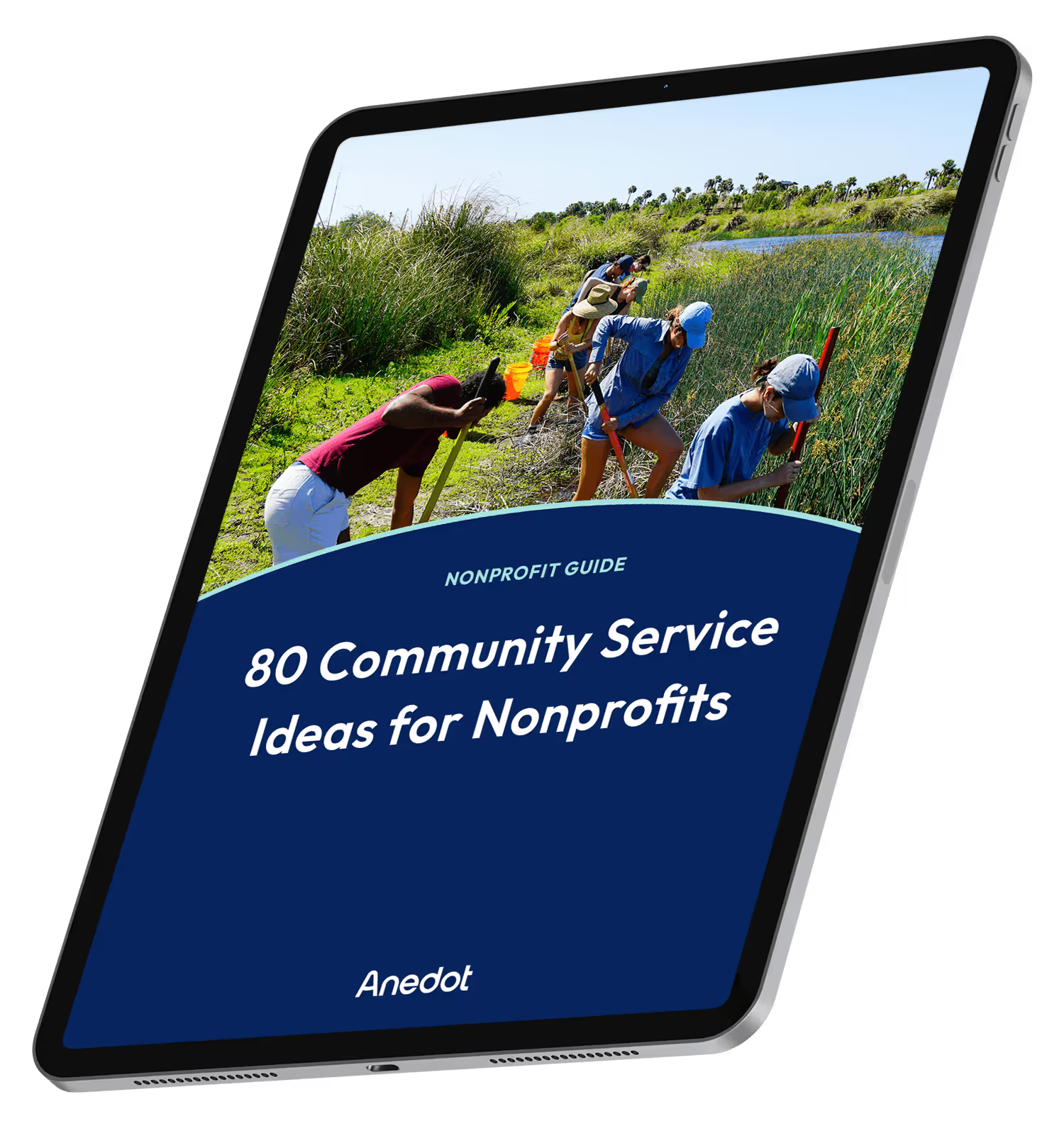
80 Community Service Ideas for Nonprofits
